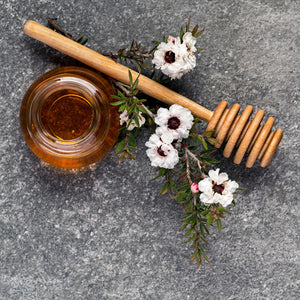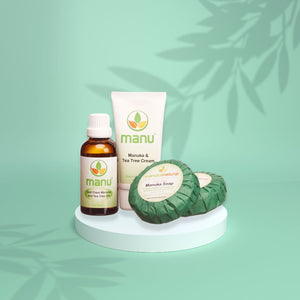
Chronic Blocked Sinus Remedy
Breathing through cocktail straws and sleeping with your mouth open? Not with Manuka honey in your cabinet
Chronic rhinosinusitis (CRS) is among the three most common chronic diseases in North America, affecting about 31 million patients in the United States annually.
It is an inflammation of the mucous membrane of the sinus cavities.
Staphylococcus aureus and Pseudomonas aeruginosa are correlated with developing this persistent severe inflammatory disease, including chronic rhinosinusitis with nasal polyps.
But when you consider chronic sinusitis treatment for the first time, you face an appointment with uninterested ‘professionals.’ 30 bucks and 3 minutes later, and off you go with a prescription for an oral steroid and MRI of the sinuses.
Hey, maybe nasal spray won’t give you a bloody nose this time?! It is made of new, never-before-seen antibiotics that can combat …x,y,z.
Yes, they may help out the first round. Then a few weeks later, symptoms usually come back.
Some MDs may also prescribe allergy pills and cold medicine, and you may think it might just be a cold that needs to ride itself out.
Of course, that isn’t the case.
By now, there is an enormous anxious thought in your head that won’t leave you.
So, today we are helping you find out how you can get rid of Chronic rhinosinusitis without side effects.
SYMPTOMS OF CHRONIC SINUSITIS
The symptoms of chronic sinusitis last for a long time. You may have the following symptoms for ten weeks or more:
A feeling of fullness in your face
Nasal obstruction or blockage
Decreased sense of smell and taste
Cough that intensifies at night
Fever
Headaches, bad breath, and sore teeth
Tiredness
What can cause chronic sinusitis?
1) STAPHYLOCOCCUS AUREUS
Staphylococcus is a type of gram-positive, aerobic bacteria, ball-shaped. There are several dozen strains of this type of bacterium. The most pathogenic strain is Staphylococcus aureus ( Staphylococcus aureus prim.aut ), translated as “golden staphylococcus.”
Staphylococcus aureus bacteria is known to develop resistance to many antibiotics quickly. It can survive in the environment for a long time, even under unfavorable conditions.
Staphylococci can be found mostly everywhere: respiratory tract, in the nose, in the throat, or on the skin of persons who may be carriers.
It is transmitted mainly by droplets, touch, through the hands, or the air.
Folks that get it usually get it from an injury or as an infection in a place like a hospital.
If you do get it, you’ll probably be fine. It can kill you, but it usually won’t.
However, this bacteria is
particularly annoying and hard to get rid of.
Even with drugs, chronic sinusitis ‘episodes’ can last for 12 weeks or a few
times a year.
Every year.
And the worst time is when you go to sleep.
Staph (Staphylococcus aureus) bacteria turns the immune system against itself: Scientists have discovered one of the keys to the massive success of S. aureus is a filthy trick — the ability to hijack a primary human immune defense mechanism and use it to destroy white blood cells.
2) PSEUDOMONAS AERUGINOSA
Pseudomonas is a menacing bacterium: It is hard to kill, defiant to many antibiotics, and can be invasive through the bones of the sinus.
It is a Gram-negative aerobic bacillus.
P. aeruginosa survives thanks to its modest needs for food and rapid reproduction. And it can live in water for months.
To find out how P. aeruginosa turns copper to its advantage, Bo Li at the University of North Carolina at Chapel Hill and her colleagues observed the bacterium growing in a copper-containing solution.
They found that this microbe produced ample fluopsin C, which inhibited other multidrug-resistant pathogens. In addition, the researchers identified 5 enzymes that P. aeruginosa uses to synthesize fluopsin C.
Then, they found the genes that code for these enzymes suggesting that the bacterium evolved to fight off competing microorganisms by weaponizing copper.
P. aeruginosa grows best in moist environments. It can thrive anywhere from a toilet to the water glass. This microbe is incredibly tough, surviving in environments that lack free oxygen.
It is one of the few species found growing in bottles of disinfectant!
P. aeruginosa also produces enzymes that contribute to its virulence. And it delivers it at a specific density to ensure they are firmly rooted before making stuff that might alert the immune system to its presence.
I.e., the enzyme neuraminidase works to enhance attachment abilities.
The kicker is that if you want to get rid of it, it requires multiple different antibiotics simultaneously, so it can’t become resistant or, at the very least, delays resistance development.
That’s some tricky bacterium to handle!
How do you treat chronic sinusitis?
Intranasal sprays containing corticosteroids may be suitable for use during chronic sinusitis.
If the cause of sinusitis is a fungus, your doctor may prescribe an antifungal drug (fungicide).
If chronic sinusitis is of allergic origin, avoiding allergen exposure may prevent the recurrence of inflammation or the need for sinus surgery.
If medications are ineffective, endoscopic sinus surgery may be an option.
Surgery is always the last option for children.
However, sinus surgery is not a permanent solution. Unfortunately, most patients who undergo sinus surgery will still need medical treatment to prevent the return of chronic sinusitis.
One thing to keep in mind is that the oral steroid will eventually cause some pretty severe side effects. That’s what steroids do, unfortunately.
So it’s your decision to think about which is worse: the sinus issues or the side effects of a steroid (which likely will entail insomnia, some water weight gain, etc.).
Several types of natural remedies can help you. In fact, several types of honey will help you get rid of chronic sinusitis (rhinosinusitis).
Chronic rhinosinusitis (CRS) natural treatment
Manuka honey from New Zealand and Sidr honey from Yemen.
Manuka honey has numerous advantages. It is a natural, inexpensive, and non-toxic product and has no adverse effects on the healing process of tissues.
To our knowledge, no research has studied the antimicrobial effect of honey on biofilms.
Until now…
What is a biofilm?
A biofilm is a group of microorganisms in which microbial cells adhere to each other. Bacterial biofilm is contagious and can lead to many infections.
According to the Institute of Public Health, about 65% of all microbial infections and 80% of all chronic infections are associated with biofilms.
Biofilm formation is a multi-stage process that begins with bacteria binding to the surface, then the formation of microcolonies that form a three-dimensional structure.
During biofilm formation, many species of bacteria communicate with each other through a specific mechanism called “quorum sensing” (a stimulation system for coordinating different gene expressions).
Surprisingly, biofilms were most susceptible where each of the Sidr and Manuka honey killed 10 of 11 isolates with a controlled rate of 91% for each.
They disrupt the synthesis of proteins, folic acid, and transpeptidase so that bacteria can no longer multiply.
In like manner, manuka honey stimulates T lymphocytes in cell culture to multiply and activate neutrophils (white blood cells).
Manuka honey is fascinating because not only does it have healing qualities due to its antibiotic content, but when exposed to oxygen or microbes (bacteria), it begins drawing these substances into itself like a sponge.
As a result, it sucks the life out of nearby organisms within seconds!
Manuka honey’s antibacterial activity is overwhelming for antibiotic-resistant pathogens. These properties derive from the honey’s complex mix of naturally occurring bacterial toxins—most notably methylglyoxal (MGO), unique to manuka honey.
This study showed that honey is far superior to antibiotics.
Honey effectively killed 100% of the isolates in the planktonic form. The bactericidal rates for the Sidr and Manuka honey against MRSA, MSSA, and PA biofilms were 63-82%, 73-63%, and 91%.
These numbers were significantly higher than those seen with single antibiotics commonly used against Staphylococcus aureus.
The experiment showed that the Sidr honey was deadly to 7 of 11 MSSA (Methicillin-sensitive Staphylococcus aureus) biofilms and the Manuka honey was cidal to 9 of 11 MSSA biofilms.
Does chronic sinusitis ever go away?
MRSA is a special type of Staphylococcus aureus.
It’s Methicillin-Resistant Staphylococcus Aureus. That means all known antibiotics can’t kill it. It exists because of the evolution of bacteria due to antibiotics.
See, antibiotics kill bacteria. So if you take antibiotics as directed, you will kill all the harmful bacteria and be cured.
But, many people don’t take antibiotics as directed. Instead of taking them for two weeks, they’ll take them for a few days until they feel a bit better.
That means they’ve killed off the weak bacteria, but the remaining ones are the stronger ones with some resistance to antibiotics. So then that person gives their infection to someone else. By now the antibiotics don’t work so well because now the bacteria have partial immunity.
Repeat this process many times over 50 years, and bacteria immune to all known antibiotics have evolved, and you get MRSA.
Drug companies are searching for new antibiotics, but development is slow.
In the antibiotics study, only Rifampin had a cidal effect against the biofilms, with a rate of 18 percent (2/11) for MSSA and 42 percent (5/12) for MRSA.
Unfortunately, because organisms develop resistance to Rifampin more rapidly, it is usually combined with other antibiotics, which limits its use.
An ideal method and agent would be practical, non-toxic, has no side effects, and is inexpensive.
Honey is an agent that meets all these criteria.
In addition, it is a natural product, and other studies have shown that it also promotes wound healing. (2)
We have discovered that honey, particularly Manuka honey from New Zealand and Sidr honey from Yemen, have in vitro bactericidal properties for SA and PA bacterial biofilms.
And these bactericidal properties are superior to those of the most commonly used antimicrobials.
In the end …
You probably keep asking yourself, can you prevent sinusitis?
There is no 100% safe way to prevent sinusitis, but there are some things that can keep that % high.
Beware of getting upper respiratory tract infections. Maintain strict handwashing habits and avoid people suffering from colds or flu.
In addition, reducing stress and a diet rich in antioxidants, incredibly fresh, dark-colored fruits, and vegetables can help strengthen the immune system.
And eat some of that delicious honey to keep your immunity sharp and potent.
ORIGINALLY PUBLISHED on blog.manukanatural.com



Leave a comment